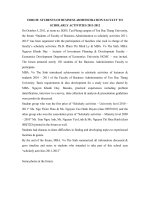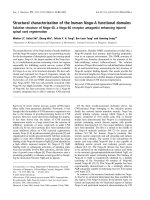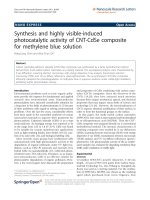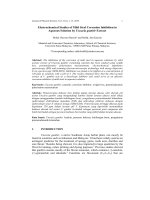Solutions of JBMO 2012 Wednesday, June 27, 2012
Bạn đang xem bản rút gọn của tài liệu. Xem và tải ngay bản đầy đủ của tài liệu tại đây (95.09 KB, 5 trang )
Solutions of JBMO 2012
Wednesday, June 27, 2012
Problem 1
Let a, b and c be positive real numbers such that a + b + c = 1 . Prove that
⎛ 1− a
a b b c c a
1− b
1− c ⎞
+ + + + + + 6 ≥ 2 2 ⎜⎜
+
+
⎟
b a c b a c
a
b
c ⎟⎠
⎝
When does equality hold?
Solution
Replacing 1 − a,1 − b,1 − c with b + c, c + a, a + b respectively on the right hand side,
the given inequality becomes
⎛ b+c
b+c c+a a+b
c+a
a+b ⎞
+
+
+ 6 ≥ 2 2 ⎜⎜
+
+
⎟
a
b
c
a
b
c ⎟⎠
⎝
and equivalently
⎛b+c
⎞ ⎛c+a
⎞ ⎛ a+b
⎞
b+c
c+a
a+b
−2 2
+ 2 ⎟⎟ + ⎜⎜
−2 2
+ 2 ⎟⎟ + ⎜⎜
−2 2
+ 2 ⎟⎟ ≥ 0
⎜⎜
a
b
c
⎝ a
⎠ ⎝ b
⎠ ⎝ c
⎠
which can be written as
2
2
2
⎛ b+c
⎞ ⎛ c+a
⎞ ⎛ a+b
⎞
− 2 ⎟⎟ + ⎜⎜
− 2 ⎟⎟ + ⎜⎜
− 2 ⎟⎟ ≥ 0 ,
⎜⎜
a
b
c
⎝
⎠ ⎝
⎠ ⎝
⎠
which is true.
The equality holds if and only if
b+c c+a a+b
,
=
=
a
b
c
1
which together with the given condition a + b + c = 1 gives a = b = c = .
3
Problem 2
Let the circles k1 and k 2 intersect at two distinct points Α and Β , and let t be a
common tangent of k1 and k 2 , that touches k1 and k 2 at Μ and Ν , respectively. If
t ⊥ AM and ΜΝ = 2ΑΜ , evaluate ∠NMB .
Solution 1
Let P be the symmetric of A with respect to M (Figure 1). Then AM = MP and
t ⊥ AP , hence the triangle APN is isosceles with AP as its base, so ∠NAP = ∠NPA .
We have ∠BAP = ∠BAM = ∠BMN and ∠BAN = ∠BNM .
Thus we have
1800 − ∠NBM = ∠BNM + ∠BMN = ∠BAN + ∠BAP = ∠NAP = ∠NPA
so the quadrangle MBNP is cyclic (since the points B and P lie on different sides of
MN ). Hence ∠APB = ∠MPB = ∠MNB and the triangles APB and MNB are
congruent ( ΜΝ = 2ΑΜ = ΑΜ + ΜΡ = ΑΡ ). From that we get AB = MB , i.e. the
triangle AMB is isosceles, and since t is tangent to k1 and perpendicular to AM, the
centre of k1 is on AM, hence AMB is a right-angled triangle. From the last two
statements we infer ∠AMB = 450 , and so ∠NMB = 90D − ∠AMB = 450 .
Figure 1
Solution 2
Let C be the common point of MN, AB (Figure 2). Then CN 2 = CB ⋅ CA and
CM 2 = CB ⋅ CA . So CM = CN . But MN = 2 AM , so CM = CN = AM , thus the right
triangle ACM is isosceles, hence ∠NMB = ∠CMB = ∠BCM = 450 .
Figure 2
Problem 3
On a board there are n nails each two connected by a string. Each string is colored in
one of n given distinct colors. For each three distinct colors, there exist three nails
connected with strings in these three colors. Can n be
a) 6?
b) 7?
Solution. (a) The answer is no.
Suppose it is possible. Consider some color, say blue. Each blue string is the side of 4
⎛ 5 ⎞ 5·4
= 10 pairs
triangles formed with vertices on the given points. As there exist ⎜ ⎟ =
⎝2⎠ 2
of colors other than blue, and for any such pair of colors together with the blue color
there exists a triangle with strings in these colors, we conclude that there exist at least
3 blue strings (otherwise the number of triangles with a blue string as a side would be
at most 2·4 = 8 , a contradiction). The same is true for any color, so altogether there
⎛ 6 ⎞ 6·5
exist at least 6·3 = 18 strings, while we have just ⎜ ⎟ =
= 15 of them.
⎝2⎠ 2
(b) The answer is yes
Put the nails at the vertices of a regular 7-gon and color each one of its sides in a
different color. Now color each diagonal in the color of the unique side parallel to it.
It can be checked directly that each triple of colors appears in some triangle (because
of symmetry, it is enough to check only the triples containing the first color).
Remark. The argument in (a) can be applied to any even n. The argument in (b) can
be applied to any odd n = 2k + 1 as follows: first number the nails as 0,1, 2 …, 2k
and similarly number the colors as 0,1, 2 …, 2k . Then connect nail x with nail y by a
string of color x + y (modn) . For each triple of colors ( p, q, r ) there are vertices
x, y, z connected by these three colors. Indeed, we need to solve (mod n) the system
(*) ( x + y ≡ p, x + z ≡ q, y + z ≡ r )
Adding all three, we get 2(x+ y + z) ≡ p + q + r and multiplying by k + 1 we get
x+ y + z ≡ (k +1)(p + q + r) . We can now find x, y, z from the identities (*) .
Problem 4
Find all positive integers x, y, z and t such that
2 x ·3y + 5z = 7t .
Solution
Reducing modulo 3 we get 5z ≡ 1 , therefore z is even, z = 2c, c ∈ ` .
Next we prove that t is even:
Obviously, t ≥ 2 . Let us suppose that t is odd, say t = 2d + 1, d ∈ ` . The equation
becomes 2 x ·3y + 25c = 7·49d. If x ≥ 2 , reducing modulo 4 we get 1 ≡ 3 , a
contradiction. And if x = 1 , we have 2·3 y + 25c = 7·49d and reducing modulo 24 we
obtain
2·3 y + 1 ≡ 7 ⇒ 24 | 2(3 y − 3) , i.e. 4 | 3 y −1 − 1
which means that y − 1 is even. Then y = 2b + 1, b ∈ ` . We obtain 6·9b + 25c = 7·49d ,
and reducing modulo 5 we get ( −1)b ≡ 2·( −1) d , which is false for all b, d ∈ ` . Hence
t is even, t = 2d , d ∈ ` , as claimed.
Now the equation can be written as
2 x ·3 y + 25d = 49d ⇔ 2 x ·3 y = ( 7d − 5c )( 7d + 5c ) .
As gcd ( 7d − 5c ,7d + 5c ) = 2 and 7d + 5c > 2 , there exist exactly three possibilities:
⎧⎪7d − 5d = 2 x −1
(1) ⎨ d d
;
y
⎪⎩7 + 5 = 2·3
⎧⎪7d − 5d = 2·3y
(2) ⎨ d d
;
x −1
⎪⎩7 + 5 = 2
⎧⎪7d − 5d = 2
(3) ⎨ d d
x −1 y
⎩⎪7 + 5 = 2 ·3
Case (1)
We have 7d = 2 x −2 + 3 y and reducing modulo 3, we get 2 x −2 ≡ 1(mod 3) , hence x − 2
is even, i.e. x = 2a + 2, a ∈ ` , where a > 0 , since a = 0 would mean 3 y + 1 = 7d ,
which is impossible (even = odd).
We obtain
mod 4
7d − 5d = 2·4a ⇒ 7d ≡ 1(mod 4) ⇒ d = 2e, e ∈ ` .
Then we have
mod 8
49e − 5d = 2·4a ⇒ 5c ≡ 1(mod 8) ⇒ c = 2 f , f ∈ ` .
mod 3
We obtain 49e − 25 f = 2·4a ⇒ 0 ≡ 2( mod 3) , false. In conclusion, in this case there
are no solutions to the equation.
Case (2)
From 2 x −1 = 7d + 5c ≥ 12 we obtain x ≥ 5 . Then 7d + 5c ≡ 0(mod 4) ,
i.e.
d
d
c
y
3 + 1 ≡ 0(mod 4) , hence d is odd. As 7 = 5 + 2·3 ≥ 11 , we get d ≥ 2 , hence
d = 2e + 1, e ∈ ` .
As in the previous case, from 7d = 2 x −2 + 3 y reducing modulo 3 we obtain x = 2a + 2
with a ≥ 2 (because x ≥ 5 ). We get 7d = 4a + 3 y i.e. 7·49e = 4a + 3 y , hence, reducing
modulo 8 we obtain 7 ≡ 3 y which is false, because 3 y is congruent either to 1 (if y is
even) or to 3 (if y is odd). In conclusion, in this case there are no solutions to the
equation.
Case (3)
From 7d = 5c + 2 it follows that the last digit of 7d is 7, hence d = 4k + 1, k ∈ ` .
If c ≥ 2 , from 74 k +1 = 5c + 2 reducing modulo 25 we obtain 7 ≡ 2( mod 25) which is
false. For c = 1 we get d = 1 and the solution x = 3, y = 1, z = t = 2 .









